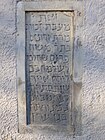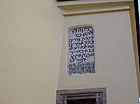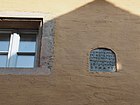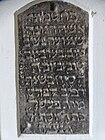Gravestones of the Regensburg Jewish cemetery
The tombstones of the Jewish cemetery in Regensburg document the importance of this community in Ashkenaz . It is estimated that over 4,000 burials took place in the cemetery in the 300 years of its existence. After the Jewish community was expelled from the imperial city (1519), citizens of Regensburg tore down the cemetery wall and stole the tombstones. Some homeowners put such a stone, inscribed in Hebrew, on their building like an anti-Jewish trophy . This was made explicit in several cases by means of meaningful inscriptions. The tombstone of the Jew Gutel was provided with a hole and since 1533 served as a lavatory for the death row inmates in the Regensburg town hall. "In a particularly disgusting way, the function of S [polia] as trophies was continued here ."
In addition to the stones that are visible in the cityscape, gravestones that have become invisible in the meantime and used as building material appear again and again. More than 100 tombstones and fragments are known in total, but not all of them are still there today or are so well preserved that the name of the deceased and the year of death can be read. The supra-regional dragging of the gravestones is noticeable and cannot be explained by the material value; they are located in an area that corresponds to the catchment area of the pilgrimage to the beautiful Madonna of Regensburg.
History of the cemetery
Outside the city of Regensburg, in the southwest in front of the Peterstor , the Jewish community acquired a piece of land in 1210 in order to use it as a cemetery . A continuous burial practice until the expulsion of the Jews in 1519 can be proven by the surviving and datable grave inscriptions. The oldest inscription dates from 1217/18, the youngest from 1516. Christian stonemasons probably acquired the necessary specialist knowledge in order to create the Hebrew inscriptions on the tombstones for Jewish clients. Details about this cooperation and the possible involvement of Jews in the making of the tombstones are not known. Christians rarely entered the cemetery area, which was enclosed by a wall (for example when a new tombstone was delivered); it was hidden from their view and thus differed considerably from contemporary Christian cemeteries, which, centrally located, were passed through every time they went to church and were places of religious and profane gatherings.
In 1519 the city council of Regensburg forced the Jewish community to leave the city. The displaced Jews then tried by legal means to restore the condition before their expulsion. In their supplication to the Innsbruck Regiment, they referred not only to their unlawful eviction, but also to the destruction of their synagogue , their houses and the cemetery. The Jewish community tried to secure the burial site in particular, because not only the tombstones had been stolen, some corpses were also dug up and desecrated (“[They] had the dead bodies dug up, knocked over, hacked, stabbed, against all the law and nature is ... “). The legal disputes ended with an imperial arbitration ruling on May 17, 1521: The parish could not return, especially since the parishioners now lived in different places of residence. They had to accept compensation for the loss of their property. The Jewish applicants were only right with regard to their cemetery: the peace of the dead was to be preserved.
The Christian population of Regensburg symbolically rededicated the cemetery area after clearing the surrounding wall and the gravestones by erecting three crosses (a calvary ) there.
Location of the Jewish cemetery
From historical sources only the approximate location of the cemetery in the extensive area "Emmeramer Breiten" was known. In 1877 a tombstone and several burials were uncovered near the canal construction on southern Maximilianstrasse . In a contemporary press report it says: "The corpses were embedded in wooden coffins, the remains of which can still be traced, and are mostly very superficial, with the bottom of the grave 2 to 3 feet below the ground ..." A few small finds were made of the 30 or so burials (Clothing applications, pendants, nails) made, "above the skeletons, sunk into the earth, there was still a broken tombstone with a Hebrew inscription."
In 2009 a team headed by the city archaeologist Lutz Dallmeier dug at Ernst-Reuter-Platz, in the green area between Maximilianstrasse and the Kepler Monument . In the Fürst-Anselm-Allee they came across grave pits under the humus, which belonged to the Jewish cemetery that existed from 1210 to 1519. The northeast corner of the medieval cemetery was located here. The archaeologists did not open these graves. In coordination with the Jewish Community of Regensburg and the Committee for the Preservation of Jewish Cemeteries in Europe, the City of Regensburg regulated that the area of the graves should be left out of the future development of the square. In 2018, archaeologists examined the area in front of Regensburg Central Station before the planned construction work, without finding any traces of the medieval cemetery.
List of preserved tombstones
The tombstones of the Jewish cemetery were stolen after 1519 and used as building material in Regensburg (a larger number of stones may have been used to build the Neupfarrkirche). Some of them were displayed on facades like anti-Jewish trophies with meaningful inscriptions. "Clearly recognizable through their Hebrew characters, even if they could not be explored in a previous meaning, the former tombs referred to a Jewish life that had been consciously abandoned."
In the following centuries the anti-Jewish purpose of the stone setting took a back seat, but the awareness remained that it was Hebrew script and therefore “Jewish stones”. Even after renovation or new construction, the tombstones were reassigned a place on the facade or in the entrance area, and the letters were also traced with color. The stones had become part of the history of the house.
| place | Installation site | Year of death | Deceased | father | description | image |
|---|---|---|---|---|---|---|
| regensburg | Historical Museum. | 1217/18 | David | Joseph | Joseph named here as father is probably identical to a Joseph who appeared as a witness when buying the cemetery property. | |
| Kelheim |
Trauntal Monastery .
( Location ) |
1220 | Vrona | Cunt | On the outer wall to the Danube. |

|
| Cham | Marketplace 2.
( Location ) |
1230 | Miriam | Ephraim | Town hall. At the bay window on the 1st floor. Under the Hebrew inscription, an inscription was subsequently added to the tombstone, reminding of the expulsion of the Jews from Regensburg in 1519 in German. |

|
| Wartberg whether the Aist |
Castle house
( Location ) |
1236 | Greta | Gershom | Wall in the entrance hall. | |
| Neuburg on the Danube | Castle Museum. | 1241 | Esther | Abraham | ||
| Kelheim | Donaustraße 16.
( Location ) |
1249 | Orgia | Judah | Facade of the city pharmacy. A relief with the depiction of a “ Judensau ” and German-language inscription was also previously on this facade: “Anno dni 1519 the Jews of Rengspurg were expelled.” The depiction of the Judensau was removed from the facade in the 19th century , but stored in the hallway. Members of the US armed forces apparently ordered the removal in 1945. |

|
| Regendorf |
Regendorf Castle .
( Location ) |
1249 | Sabbatai | Menachem | Façade on the west side in the entrance area of the southern courtyard. The client was Reich Coin Master Martin Lerch. | |
| regensburg | Cathedral Square.
( Location ) |
1251 | Jerachmiel | Simcha | St. Peter's Cathedral . Floor in the north-eastern wing of the cloister. | |
| regensburg | Historical Museum. | 1252 | Plume | Joseph | Original of the stone that was on the facade of the building in front of Grieb 1 on the 2nd floor; a copy of the stone was placed there. |

|
| Tegernheim | Kirchstrasse 18.
( Location ) |
1252 | Meschullam | Judah | In the front yard of the cath. Rectory. Attached to the gable wall of a parsonage barn from 1534 to 1968; restored and presented there for the exhibition “Wittelsbach and Bavaria” (1980). | |
| regensburg | Historical Museum. | 1260 | Guthil | Jacob | ||
| regensburg | Historical Museum. | 1273 | Esther ha-ialda | “Jewish gravestone with Hebrew inscription, walled up in the dazzling ashlar of the pedestal of the Neupfarrkirche with the writing turned inwards. The same thing was triggered [during construction work in 1929]. " | ||
| Nuremberg | Germanisches Nationalmuseum . | 1282 | Israel | Joseph |

|
|
| Cloud ring | Kirchberggasse.
( Location ) |
1292 | Dobrosława | Nathanael | To the right of the gate of the churchyard wall. |

|
| Mintraching | Stadlergasse 2a. | 1294 | Josiphja | Shalom | Under the canopy of the funeral hall of the cemetery. | |
| St. Martin im Innkreis | District this side .
( Location ) |
1294 | Rachel | Tobia | Southern exterior facade of the cath. Parish church of St. Martin im Innkreis . |

|
| Kelheim | Trauntal Monastery.
( Location ) |
13th Century | Perla | Mordecai | Interior of the rock church. | |
| regensburg | Historical Museum. | 1312 | Cunt | Isaac | ||
| regensburg | Historical Museum. | 1316 | Frodin | Shalom | Children's tombstone. | |
| regensburg | 1325 | Gnenna | Awigdor ha-Kohen | Formerly on the facade of the house on Minoritenweg 14, which was demolished in the 20th century. | ||
| regensburg | Historical Museum. | 1326 | Joseph | Jechiel | Apparently free-standing in the 18th century, "zu Prebronn am Brunnen." | |
| Straubing | Gäubodenmuseum . | 1328 | Asaria | Hosea | The tombstone was probably a reworked sarcophagus lid. Original in the Gäubodenmuseum, copy in Rosengasse 14. |

|
| regensburg | Historical Museum. | 1335 | Gitel | Nachman | In the 18th century it was probably free-standing "on the cow meadow". | |
| regensburg | Rathausplatz 1.
( Location ) |
1336/37 | Gutel | David | Old town hall, abortion plate in the dungeon prison. | |
| regensburg | Historical Museum. | 1344 | Isak | Nissim | ||
| regensburg | Historical Museum. | 1349 | Menachem | Jacob | In the 18th century at Leipolds Stadel, Bismarckplatz 9. | |
| regensburg | Historical Museum. | 1371 | Lea and Sara | Ephraim | Double tombstone for two sisters; both are called "beautiful". | |
| regensburg | At the Judenstein. | 1374 | Cunt | Joseph | In front of the facade of the secondary school. "In Regensburg, since the turn of the 17th century, different and then a single stone has been understood and highlighted as a jewish stone [...] The correspondingly designated monument has been demonstrably used as a location marker since the 17th century." |

|
| regensburg | Keplerstrasse 14th
( Location ) |
1380 | Michlin and Alexander | Abraham | Installed in the interior of the restaurant. The representative building was built in 1527 as a wine bar.
Double tombstone, probably reworked Roman sarcophagus lid. |
|
| regensburg | Emmeramsplatz 11.
( Location ) |
1380 | Baruch | Chaim | Protestant hospital, exterior facade.
In the 18th century "Am Bruderhaus", Obere Bachgasse 22. |

|
| Eferding | Stadtplatz 37.
( Location ) |
1406 | Prive, wife of Joseph | Jechja ha-Levi | At the former Löwenwirtshaus, with added inscription: “Anno domini 1518 written steadily. Did you drive out the jews of the Regenspurg ”and name of the house owner T. Schnaittenpart. |

|
| Straubing | Gäubodenmuseum | 1430 | Merlin | Simon ha-Levi | From Obermotzing Castle . | |
| regensburg | Neue-Waag-Gasse 2.
( Location ) |
1463 | Gutrut | Jacob ha-Levi | Left wall of the gate passage.
The stone is visible from both sides. Front: Hebrew epitaph. The coats of arms of the house owners Martin Lerch and Dorothea nee were placed on the base of the tombstone. Kastner attached. Reverse: One-line Hebrew name inscription, above it the Lerch and Kastner coats of arms. Underneath the following inscription: "In the 1519th year on the 22nd day Hornung the Jews were expelled here to Regenspurg." |

|
| regensburg | Neupfarrplatz 7.
( Location ) |
1482 | Pessel | Joseph | Left wall of the gate passage. |

|
| regensburg | Haidplatz 1.
( Location ) |
14./15. century | Jutta | Isaac | Wall in the stairwell. | |
| regensburg | Behind the Grieb 2.
( Location ) |
1516 | Gnennlin | Jekutiel | On the west facade of the courtyard. | |
| regensburg | Rathausplatz 1 / Roter Herzfleck.
( Location ) |
[...] | Transition from the old to the new town hall, on a console on the 1st floor. |

|
||
| regensburg | Brückstrasse 2.
( Location ) |
[...] | Kneblein | Facade of the Amberger Salzstadel on the 1st floor. Gravestone fragment with two added dates 1519 and 1551. | ||
| regensburg | Krauterermarkt 3.
( Location ) |
[...] | Bishop's court . North wing of the inner courtyard, under plaster since renovation. | |||
| regensburg |
Neupfarrplatz .
( Location ) |
[...] | Ev. Luth. Neupfarrkirche . Floor slab of the spiral staircase in the south tower. | |||
| regensburg | Neupfarrplatz.
( Location ) |
[...] | Ev. Luth. Neupfarrkirche. Several stones in the north tower. | |||
| regensburg | Historical Museum. | [...] | Converted into a loopholes. | |||
| regensburg | Historical Museum. | Guta | Cunt | |||
| regensburg | Historical Museum. | [...] | ||||
| regensburg | Historical Museum. | Jacob and his son Joseph | Joseph | Double tombstone for father and son. | ||
| regensburg | Historical Museum. | Lovely | Ascher, a scholar | Tombstone set by husband; with Schöne, the family of origin was obviously important. | ||
| regensburg | Historical Museum. | Horse | Mordecai ha-Kohen | "I cry and scream in bitterness over the young girl, Pferdli of blessed memory [...]" | ||
| Mangolding | Kirchstrasse.
( Location ) |
[...] | Left of the entrance of the cath. Parish Church of St. Peter. |

|
The list that Georg Heinrich Paricius created in 1724 shows that the stones were relatively movable and that the installation location at that time often does not correspond to the one today:
- House of Mr. Fox; today on the same property, Neupfarrplatz 7, integrated into the new building.
- Mr. Weißböck's house; today at the same house, Hinter der Grieb 2.
- Mr. Krütinger's printing house, opposite the town hall; lost today.
- Fencing school in the wall on the stairs; Today at the same house, Neue-Waag-Gasse 2.
- Brother house; today: Emmeramsplatz 11.
- Mr. Leypold's barn; today in the Historical Museum.
- House of the musician Lorentz Sametinger next to the Mohrenwirt; lost today.
- Jesuit seminary (ie former Obermünster women's monastery, largely destroyed by fire in 1809); the tombstone is lost.
- Dominican monastery; lost today.
- Dominican monastery; lost today.
- Zeughaus opposite the brewery; lost today.
- So-called Judenstein - still on the street named after him and meanwhile badly weathered.
- To Prebronn at the fountain; today in the Historical Museum.
- On the cow meadow; today in the Historical Museum.
- Town servant house behind the Grüb; today in the Historical Museum.
literature
- Andreas Angerstorfer : "Because the stone will scream out of the wall ..." (Hab 2:11). Jewish spolia from Regensburg in an anti-Semitic function . In: Das Münster 60 (2007), pp. 23–30.
- Michael Brocke : The famous medieval Jewish cemetery of Regensburg and its tombstones . In: Archäologie 2016/1, pp. 34–36.
- Susanne Härtel: Jewish cemeteries in the medieval empire . Walter de Gruyter, Berlin / Boston 2017, ISBN 978-3-11-053560-0 .
- Susanne Härtel: How things are presented. On the paths of Jewish gravestones from Regensburg . In: Frühmittelalterliche Studien 46 (2012), pp. 485–512.
- Eva Haverkamp-Rott , Astrid Riedler-Pohlers: Regensburg - medieval metropolis of the Jews (= cultural guide Regensburg. Volume 15). Regensburg 2019. ISBN 978-3-943222-51-7 .
- Georg Heinrich Paricius: Regensburg, now living in 1724, or Kurtzgefaßte message of the current state of salvation. Roman Empire Freyen City of Regensburg . Self-published, Regensburg 1724, pp. 177–195. ( Digitized ) Descriptions of Jewish gravestones known in the 18th century.
- Siegfried Wittmer: The six cemeteries of the Regensburg Jews. In: Negotiations of the Historical Association for Upper Palatinate and Regensburg 141 (2001), pp. 81–93. ( PDF )
Web links
- House of Bavarian History : Jewish cemeteries in Bavaria - Regensburg
- Alemannia Judaica: Regensburg - The Jewish cemeteries
Individual evidence
- ↑ Susanne Härtel: How things are presented. On the ways of Jewish gravestones from Regensburg , 2012, p. 498. Shown here using the example of Mayor Caspar Amman, who had the Gnennelin's gravestone inscribed: “The stone was given a new meaning: It praised the expulsion of the Jews and captured the memory of them - in precise chronological order - in a triumphant way. "
- ^ Jürgen Wiener: Art. Spolie . In: Enzyklopädie der Neuzeit , Volume 12, Col. 376-380, here Col. 379.
- ↑ Susanne Härtel: How things are presented. On the ways of Jewish gravestones from Regensburg , 2012, p. 486 note 6.
- ↑ Susanne Härtel: How things are presented. On the ways of Jewish gravestones from Regensburg , 2012, p. 491.
- ↑ Susanne Härtel: How things are presented. On the paths of Jewish gravestones from Regensburg , 2012, p. 493.
- ↑ Susanne Härtel: Jewish Cemeteries in the Medieval Empire , Berlin / Boston 2017, p. 106.
- ↑ Quoted from: Susanne Härtel: Jüdische Friedhöfe im Medieval Reich , Berlin / Boston 2017, p. 189, note 134.
- ↑ Susanne Härtel: Jewish Cemeteries in the Medieval Empire , Berlin / Boston 2017, p. 191.
- ↑ Susanne Härtel: Jewish Cemeteries in the Medieval Empire , Berlin / Boston 2017, p. 189.
- ↑ a b c City of Regensburg: No trace of the Jewish cemetery , July 25, 2018, updated October 18, 2018.
- ↑ The old Jewish cemetery in Regensburg .
- ↑ Susanne Härtel: How things are presented. On the paths of Jewish gravestones from Regensburg , 2012, p. 500.
- ↑ Susanne Härtel: How things are presented. On the paths of Jewish gravestones from Regensburg , 2012, p. 501.
- ↑ a b c d e f g Susanne Härtel: Jewish cemeteries in the medieval empire , Berlin / Boston 2017, p. 357.
- ^ Eva Haverkamp-Rott, Astrid Riedler-Pohlers: Regensburg - Medieval Metropolis of Jews , Regensburg 2019, p. 32.
- ↑ Eva-Maria Bast and Heike Thissen: “Judenmahnstein” in lofty heights . In: Mittelbayerische Zeitung, December 8, 2015.
- ↑ Susanne Härtel: How things are presented. On the ways of Jewish gravestones from Regensburg , 2012, p. 499.
- ^ Susanne Härtel: Jewish cemeteries in the medieval empire , Berlin / Boston 2017, pp. 259, 265.
- ↑ a b c d e f g Susanne Härtel: Jewish cemeteries in the medieval empire , Berlin / Boston 2017, p. 358.
- ^ Parish of the Annunciation Tegernheim: Small monuments
- ^ Excavations in 1929 in the Neupfarrkirche in Regensburg. List of finds.
- ^ Object catalog of the Germanisches Nationalmuseum: Gravestone of the boy Israel, son of Rabbi Joseph
- ↑ a b c d e f g Susanne Härtel: Jewish cemeteries in the medieval empire , Berlin / Boston 2017, p. 359.
- ↑ a b c d e f Susanne Härtel: Jewish cemeteries in the medieval empire , Berlin / Boston 2017, p. 363.
- ^ Eva Haverkamp-Rott, Astrid Riedler-Pohlers: Regensburg - Medieval Metropolis of Jews , Regensburg 2019, p. 84 f.
- ↑ Susanne Härtel: How things are presented. On the ways of Jewish gravestones from Regensburg , 2012, p. 492. 509.
- ↑ Susanne Härtel: Jewish Cemeteries in the Medieval Empire , Berlin / Boston 2017, p. 360.
- ↑ Andreas Angerstorfer: "Because the stone will scream out of the wall ..." (Hab 2:11). Jewish Spolia from Regensburg in an anti-Semitic function , 2007, p. 28. Hiram Kümpe: Materialwissenschaft Mediävistik. An introduction to historical auxiliary sciences , Paderborn 2014, p. 185: "A notorious case of such a new use is the abortion seat in the Regensburg town hall from 1533, which consists of the tombstone for the Jewess Gutel, who died in 1336/37."
- ↑ a b c Susanne Härtel: Jewish cemeteries in the medieval empire , Berlin / Boston 2017, p. 360.
- ^ Eva Haverkamp-Rott, Astrid Riedler-Pohlers: Regensburg - Medieval Metropolis of Jews , Regensburg 2019, p. 86.
- ↑ Susanne Härtel: Jewish Cemeteries in the Medieval Empire , Berlin / Boston 2017, p. 276, note 218.
- ↑ a b c d Susanne Härtel: Jewish cemeteries in the medieval empire , Berlin / Boston 2017, p. 361.
- ↑ Digital State Library Upper Austria: The Jews in Linz .
- ↑ a b c Susanne Härtel: Jewish cemeteries in the medieval empire , Berlin / Boston 2017, p. 259 f. 362.
- ↑ a b c d e Susanne Härtel: Jewish cemeteries in the medieval empire , Berlin / Boston 2017, p. 364.
- ^ Eva Haverkamp-Rott, Astrid Riedler-Pohlers: Regensburg - Medieval Metropolis of Jews , Regensburg 2019, p. 84.
- ^ Eva Haverkamp-Rott, Astrid Riedler-Pohlers: Regensburg - Medieval Metropolis of Jews , Regensburg 2019, p. 85.
- ^ Eva Haverkamp-Rott, Astrid Riedler-Pohlers: Regensburg - Medieval Metropolis of Jews , Regensburg 2019, p. 87.
